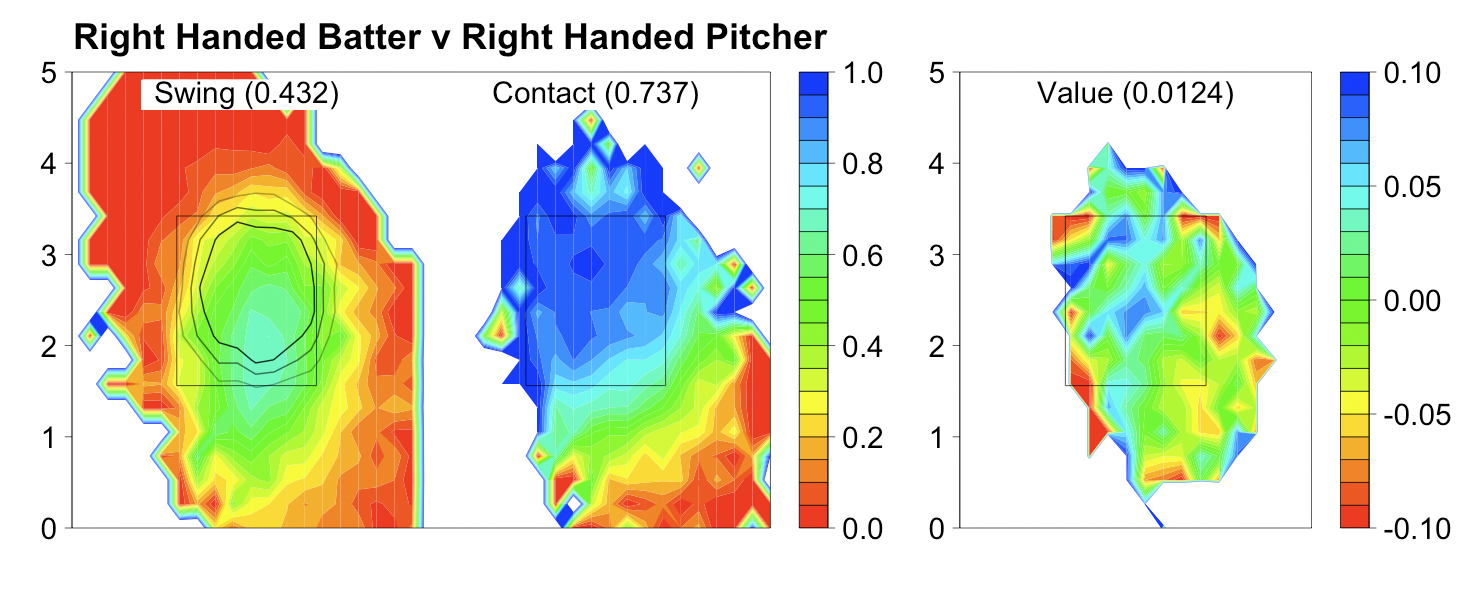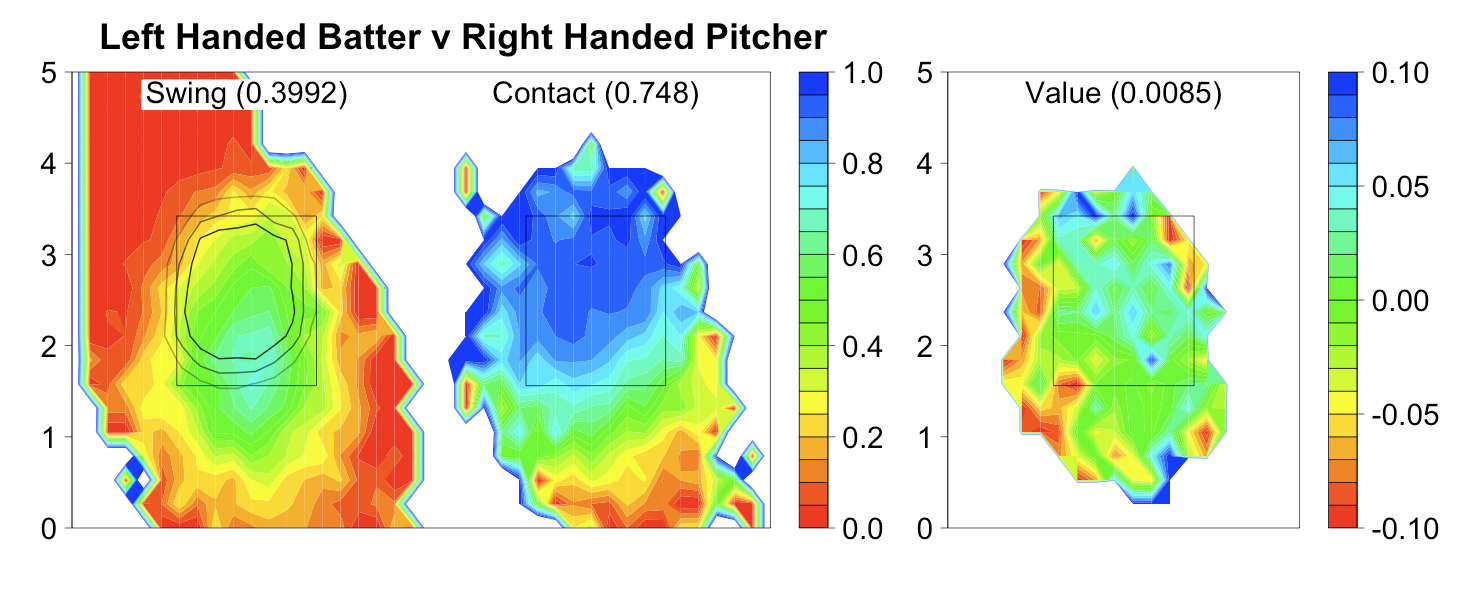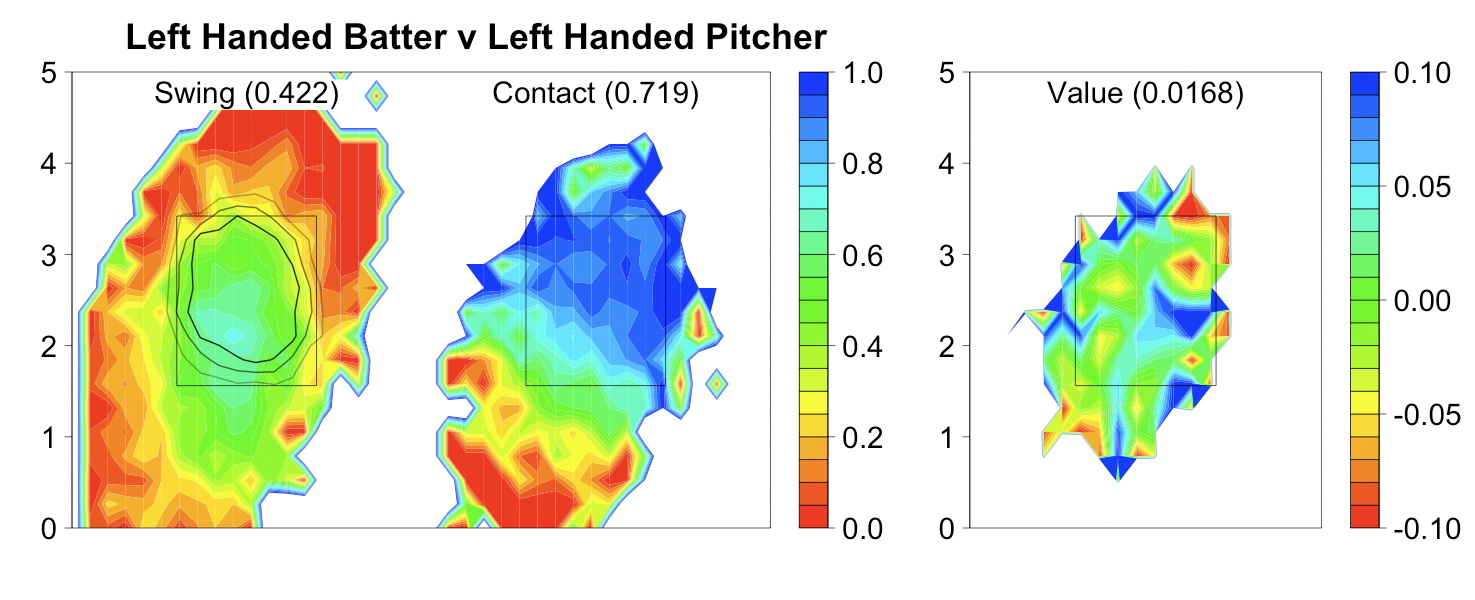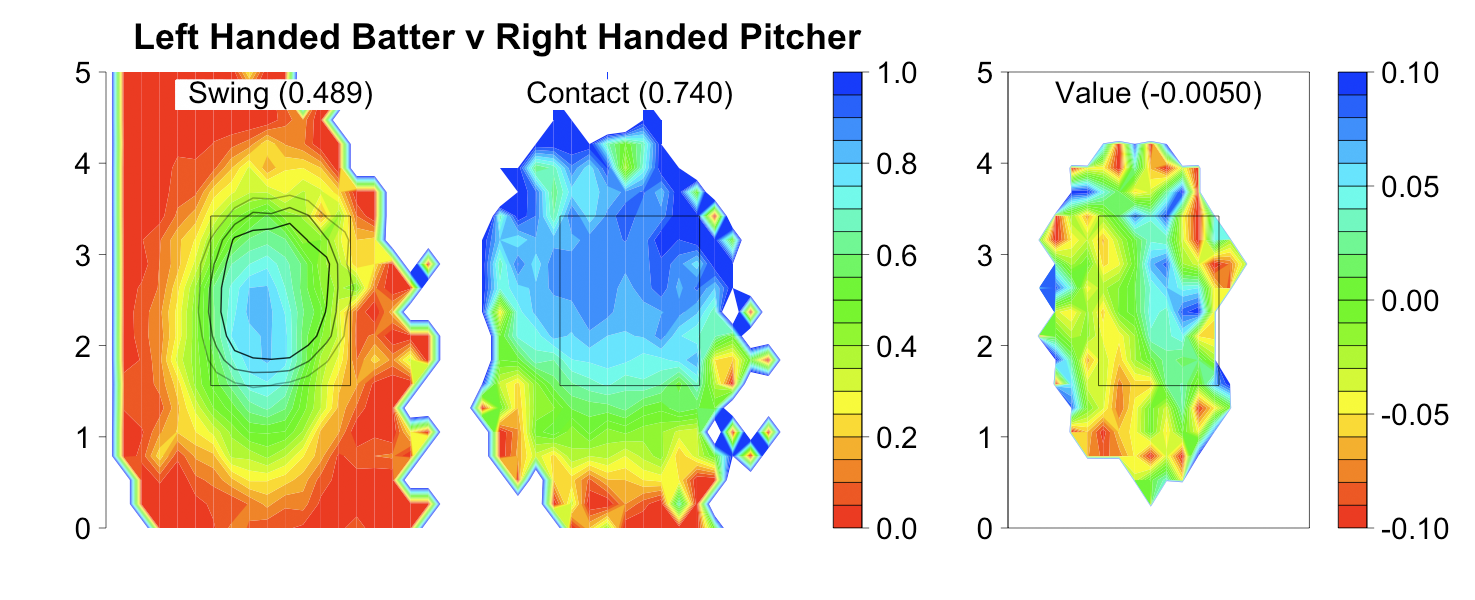
| F/X Visualizations | March 30, 2009 |
In this post I continue, and finish, my series deconstructing the pitch specific run value maps that I first presented here. In the first entry I broke down the different events that contributed to the run value maps for fastballs, here I will do the same for the remaining three pitches I looked at: curveballs, changups and sliders.
Recall, from the fastball post, the methodology I use:
The run value of a pitch is determined by the outcome of four events.
- If the batter swings at the pitch or not.
- If no to 1, whether the taken pitch is called a ball or a strike.
- If yes to 1, whether the batter makes contact.
- If yes to 3, the run value of that contact.
Below I present a series of three images for each handedness combination that show how the outcomes of these four events vary by location for fastballs. Reading left to right:
At the top of each image is the average value over all locations.
- The first image addresses events 1 and 2. The heat map is the swing percentage by location to address 1. On top of that are three contour lines where 75%, 50% and 25% of taken pitches were called strikes to address 2. So if a batter took a pitch inside the smallest circle it was called a strike over 75% of the time. If he took a pitch in doughnut between the smallest and middle circles it was called a strike between 75% and 50% of the time, and so on.
- The second image addresses 3 showing the contact percentage of pitches swung at.
- The final image addresses 4 showing the run value of a contacted pitch (including foul balls).
Since there are fewer curveballs, changeups and sliders than fastballs I smoothed and regressed the data more to make the images below. Thus they are not as finely resolved as the fastball images, but, I think, still convey the patterns well.
For each pitch I first present the original run value map. Recall the number at the top of each image is the percentage of time that pitch type is thrown in those at-bats.

Curveballs are thrown roughly equally in the different handedness combinations and have a large area of negative to zero run valued pitches below the strike zone.

Batters swing less at curveballs than fastballs, and the swing map is much less coincident with the strike zone for curveballs than fastballs. So batters are taking more curveballs for strikes and swinging at more curveballs out of the zone compared to fastballs. In addition, batters whiff more against curveballs than fastballs. But when they do make contact the run value is positive compared to negative run-valued contact versus fastballs.
Batters tend to swing more at curveballs down and slightly away, but make contact at a higher rate and better contact at curveballs up and in. Most likely this is a result of the down and away break of curveballs. Pitches that do break (or break a lot) end up down and away, and batters miss them or make poor contact. Pitches that don't break (or not enough) end up up and in, and batters rarely miss and make good contact.
Another interesting aspect of these images is how the strike zone is called for curveballs. The top, bottom and away edges are called in the same manner as fastballs are to RHBs, but the inside edge seems different. Recall that fastballs were called correctly along the inside edge, but curveballs are called considerable away (the 25% strike contour is inside the rule book edge). So umpires are calling inside fastballs strikes against RHBs, but not inside curveballs. I am not sure if this is a statistically significant difference, but I will look at that in a future post.

As expected RHBs make more and better contact against curveballs from LHPs than curveballs from RHPs. The orientation of the contact percentage gradient has shifted and is now high up and away to low down and in. This is a result of LHPs' curveballs breaking in to RHBs.

The swing percentage and contact rates are similar to RHBvLHP, but the run value of contacted pitch is, strangely, much lower. The orientation of the contact percentage gradient is the same as the one we saw in RHBvRHP.

Like for fastballs lefties facing lefties have the lowest contact rate by a large margin. But surprisingly the run value of contacted pitches is highest here, which was not the case for fastballs.
The orientation of the contact percentage gradient here looks like that seen in RHBvLHP not like the one seen in LHBvRHP. With fastballs the contact percentage and run value location patterns were determine by the hitters (RHBvRHP was more similar to RHBvLHP than to LHBvRHP) but with curveballs it is the pitchers handedness that determines the pattern (RHBvRHP is more similar to LHBvRHP than to RHBvLHP). It seems that the break of the pitch (determined by the handedness of the pitcher) is more important in determining these patterns than the inside/outside preference of the batter, which drove the fastball patterns.
Now we turn our attention to changeups. Here are the overall run value maps.

Changeups are thrown mostly in at-bats when the pitcher and batter have opposite handedness. So I will only present and comment on those images. But you can see the rightie/rightie one here and leftie/leftie one here.


Batters swing at changeups more than either fastballs or curveballs, and the swing percentage map is more coincident with the strike zone contours for changeups than for fastballs and curveballs. Meaning batters take fewer changeups for strikes and swing at fewer changeups out of the zone than for the previous pitch types. The highest swing percentage is slightly away and down, rather than up and in for fastballs.
Although batters swing at a lot of changeups and swing at the right pitches (in terms of the strike zone), they whiff on changeups at a relatively high rate. The highest contact rate and run value of contact are both up and in. Contacted pitches have a very slightly negative run value.
The strike zone to RHBs is called away on both the inside and outside edges and high on both the bottom and top edges. To lefties it is called away just on the outside edge and high just on the bottom edge. Again I am not sure these are statistically significant differences.
Finally, looking at sliders, here are the overall run value maps.

Sliders are thrown mostly in at-bats when the pitcher and batter have same handedness. So I will only present and comment on those images. But you can see the other ones here and here.


In same handed at-bats sliders are just nasty pitches. Batters swing at sliders slightly more often than fastballs (less than changeups and more than curves). But they are swinging at the wrong pitches, as the swing percentage map is considerably off from the strike zone (almost as bad as with curveballs). The whiff rate on sliders is enormous, considerably higher than any other pitch type. There is only a small part of the zone middle-in with a contact rate of over 85%. And then, even when batters make contact, the result has a negative run value.
.
Wrapping Up
We are now in a position to make some broad statements about what make the different pitch types successful.- Fastballs: With the exception of those directly above the strike zone, batters tend to swing at fastballs in the zone and take those out. They also whiff on fastballs at the lowest rate of any pitch. But contacted fastballs have very negative run values, the lowest of all pitches.
- Curveballs: Batters routinely take curveballs in the strike zone and swing at a high rate at curveballs below the strike zone. They whiff at a moderate rate. But when they make contact the run value is positive and higher than for all other pitches.
- Changeups: Batters tend to swing at changeups in the zone and take those out of the zone. But batters whiff against changeups at a moderate rate and contacted changeups have slightly negative run values.
- Sliders seem to have the best aspects of each pitch: the swing rate map is only slightly more coincident with the strike zone than that for curveballs, the whiff rate is higher than any other pitch, and contacted sliders have a negative run value (although not as low as contacted fastballs).
Below I present the overall run value per pitch separated by pitch type in a chart and figure. In the figure I indicate the standard errors.
Run value per pitch +------------+------------+------------+------------+------------+ | B/P hand | Fastballs | Curveballs | Changeups | Sliders | +------------+------------+------------+------------+------------+ | RHB/RHP | -0.0032 | -0.0009 | 0.0014 | -0.0057 | | RHB/LHP | 0.0030 | 0.0031 | 0.0011 | 0.0056 | | LHB/RHP | 0.0034 | -0.0008 | 0.0012 | 0.0013 | | LHB/LHP | -0.0035 | 0.0005 | 0.0003 | -0.0092 | +------------+------------+------------+------------+------------+

Fastballs and sliders show a statistically significant platoon split: there is a significantly lower run value outcome when the pitcher and batter have same handedness than when they have different. This makes sense with usage patterns for sliders, which are pitched more in at-bats when the batter and pitcher have the same handedness. You can also see here just how nasty sliders are to same handed batters, significantly lower than any other pitch.
Curveballs are interesting, there is no significant platoon split and there is a trend (although not significant) for curveballs from LHPs to have higher run value outcomes than curveballs from RHPs. This is strange as lefties throw curveballs more often than righties.
Changeups show no statistically significant platoon split. Which, again, is in line with what we expect based on their usage pattern. They are mostly thrown in opposite handed at-bats when fastballs or sliders would have a relatively higher run value.
This analysis has some serious limitations. I am using the MLB pitch classifications, which are far from perfect. There has been some work on developing better classification algorithms and I hope to incorporate one such algorithm in my future analysis. The pitches in this analysis are averaged over all pitch speeds and breaks, which is a major limitation. Just recently Dan Turkenkopf looked at how pitch speed impacted at-bat outcomes, and it would be interesting to see how pitch speed affects at-bat outcomes for each pitch type separately. Finally I average over all pitch counts. My next post will begin to address this last concern.
Comments
Fascinating stuff.
I studied platoon splits for different pitch types (the article appeared in the THT Annual 2008) and I found the same thing that you find here: fastball and slider, big splits, curveball and changeup, small (or no) splits.
I was surprised by the fastball and curveball results, so I'm glad that you confirm!
Posted by: John Walsh at March 31, 2009 3:23 AM
John,
I am ashamed to say that I did not have the 2008 (although I have seen the error of my ways and have the 2009 Annual). I will have to track down the 2008 and check out your article. It is reassuring that our results are in agreement.
Posted by: Dave at March 31, 2009 7:47 AM